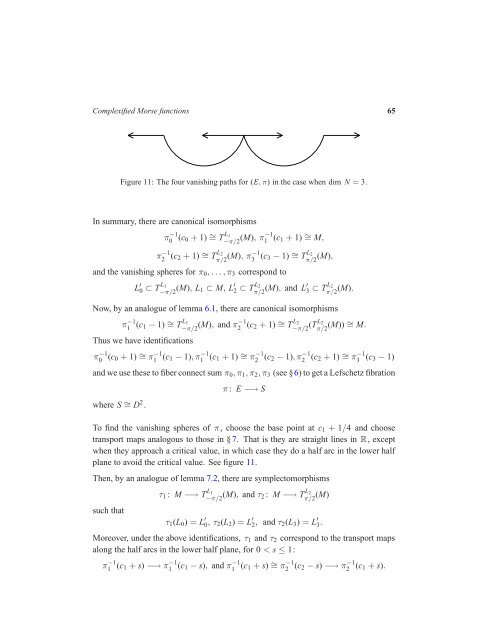The Picard-Lefschetz theory of complexified Morse functions 1 ...
The Picard-Lefschetz theory of complexified Morse functions 1 ...
The Picard-Lefschetz theory of complexified Morse functions 1 ...
You also want an ePaper? Increase the reach of your titles
YUMPU automatically turns print PDFs into web optimized ePapers that Google loves.
Complexified <strong>Morse</strong> <strong>functions</strong> 65<br />
Figure 11: <strong>The</strong> four vanishing paths for (E, π) in the case when dim N = 3.<br />
In summary, there are canonical isomorphisms<br />
π −1<br />
0 (c0 + 1) ∼ = T L1<br />
−π/2 (M), π−1<br />
1 (c1 + 1) ∼ = M,<br />
π −1<br />
2 (c2 + 1) ∼ = T L2<br />
π/2 (M), π−1<br />
3 (c3 − 1) ∼ = T L2<br />
π/2 (M),<br />
and the vanishing spheres for π0,...,π3 correspond to<br />
L ′ 0 ⊂ T L1<br />
−π/2 (M), L1 ⊂ M, L ′ 2 ⊂ T L2<br />
π/2 (M), and L′ 3 ⊂ T L2<br />
π/2 (M).<br />
Now, by an analogue <strong>of</strong> lemma 6.1, there are canonical isomorphisms<br />
π −1<br />
1 (c1 − 1) ∼ = T L1<br />
−π/2 (M), and π−1<br />
2 (c2 + 1) ∼ = T L2<br />
−π/2 (TL2 π/2 (M)) ∼ = M.<br />
Thus we have identifications<br />
π −1<br />
0 (c0 + 1) ∼ = π −1<br />
1 (c1 − 1),π −1<br />
1 (c1 + 1) ∼ = π −1<br />
2 (c2 − 1),π −1<br />
2 (c2 + 1) ∼ = π −1<br />
3 (c3 − 1)<br />
and we use these to fiber connect sum π0,π1,π2,π3 (see §6) to get a <strong>Lefschetz</strong> fibration<br />
where S ∼ = D 2 .<br />
π : E −→ S<br />
To find the vanishing spheres <strong>of</strong> π, choose the base point at c1 + 1/4 and choose<br />
transport maps analogous to those in §7. That is they are straight lines in R, except<br />
when they approach a critical value, in which case they do a half arc in the lower half<br />
plane to avoid the critical value. See figure 11.<br />
<strong>The</strong>n, by an analogue <strong>of</strong> lemma 7.2, there are symplectomorphisms<br />
such that<br />
τ1 : M −→ T L1<br />
−π/2 (M), and τ2 : M −→ T L2<br />
π/2 (M)<br />
τ1(L0) = L ′ 0, τ2(L2) = L ′ 2, and τ2(L3) = L ′ 3.<br />
Moreover, under the above identifications, τ1 and τ2 correspond to the transport maps<br />
along the half arcs in the lower half plane, for 0 < s ≤ 1:<br />
π −1<br />
1 (c1 + s) −→ π −1<br />
1 (c1 − s), and π −1<br />
1 (c1 + s) ∼ = π −1<br />
2 (c2 − s) −→ π −1<br />
2 (c1 + s).
















